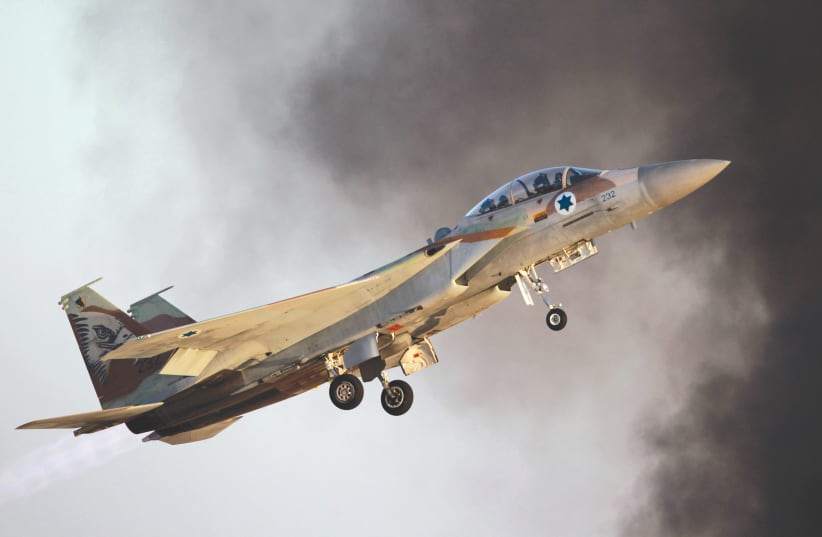"The operation was long-planned and reflects extraordinary collaboration with military intelligence and the Air Force,” Brig.-Gen. Levine stated.
By AMIR BOHBOT SEPTEMBER 28, 2024 18:38 Updated: SEPTEMBER 28, 2024 18:53 THE PILOTS – who put their lives on the line so we, the majority, can sleep safely at night – feel that the country to which they have committed their lives is changing.
(photo credit: BOAZ RATNER/REUTERS)
THE PILOTS – who put their lives on the line so we, the majority, can sleep safely at night – feel that the country to which they have committed their lives is changing.
(photo credit: BOAZ RATNER/REUTERS)
Brig. Gen. Amichai Levine, the newly appointed commander of the IAF's Hatzerim Airbase, revealed on Saturday that the mission to eliminate Hassan Nasrallah demanded unique, world-class capabilities from the Israeli Air Force.
The operation required extreme precision to strike a deep underground area while maintaining perfect deception, ensuring that Hezbollah officials such as Nasrallah, Ali Karaki, and other senior figures would not detect the attack and escape.
“The operation succeeded perfectly,” Levine said, praising the ground crews and technical teams for their seamless execution. Not only did they ensure the aircraft’s readiness, but they also managed the munitions, which performed flawlessly despite the complex mission conditions. “About a hundred munitions were used, with bombers dropping them every two seconds in perfect precision.”
He also commended Squadron 69, known as the "Hammers," which operates the F-15I Ra'am fighter jets and has been involved in notable operations in Lebanon and Syria. The squadron faced scrutiny before the war due to protests against the judicial reform, but for 11 months, the squadron’s pilots, both reservists and regulars, have been on continuous alert for missions across the Middle East, ready for future challenges.
When asked about Squadron 69’s involvement amid the protests over the judicial reform before October 7, Levine responded: “Squadron 69 is a strategic squadron in the Air Force and has been for decades. It’s responsible for some of the Air Force’s most critical missions. The squadron's fighters are diverse in profession and age (up to 50 years old).
“Fifty percent of them are reservists, and roughly 50% of the soldiers who participated in this operation were reservists. No one in Israel should doubt their love for the country, their willingness to sacrifice their lives, and even put their lives on the line for both nearby and distant missions. I think this operation underscores that. For 11 months, they’ve been on alert, flying around the clock, and they’ll continue as long as the war goes on.
The IDF's three goals
“We have three goals: returning the hostages, dismantling Hamas, and ensuring the safe return of northern residents to their homes," he continued. "Despite the media focus, the base and squadron, along with the entire Air Force, are operating powerfully,” Brig.-Gen. Levine stated.
“The separation of the northern and southern fronts is critical to dismantling Hamas and creating the conditions necessary to bring back the hostages. Yesterday, we executed a historic operation of immense strategic importance. Nasrallah is seen as the most central figure in the Shiite axis. This will have a significant impact on the Middle East and move us closer to achieving our war goals.
"The operation was long-planned and reflects extraordinary collaboration with military intelligence and the Air Force. I know all the intelligence officers who contribute incredible capabilities.”
“What was missing before October 7 was initiative and aggressiveness," Levine added. "We still have unfinished business: we need to root out Hamas, and we haven’t brought the hostages home. There are still issues that require our attention.”
Stay updated with the latest news!
Subscribe to The Jerusalem Post Newsletter
He further acknowledged Brig.-Gen. Guy Davidson, the outgoing commander of Hatzerim Airbase: “Davidson deserves a lot of credit. Two weeks ago, I received a base that is a well-oiled war machine. However, there are many people who deserve recognition for their recent performances. Davidson is certainly one of these key and valued individuals,” he said, adding, “Davidson was my flight instructor many years ago, and I owe him personal credit.”
“The challenge in elimination operations is precise intelligence,” Levine explained. “All agencies need to provide intelligence for every operation. The second challenge is ensuring that the target—Nasrallah, Karaki, and others—does not escape while the planes are en route or the munitions are on their way to the target. Each time, this is done creatively and through various methods, relying on ideas from young officers who are given the freedom to think and senior ranks who listen to them. They bring innovative solutions to deceive our enemies, ensuring the target remains stable during execution. Surface-to-air missiles in Lebanon still pose a threat, but we’ve also targeted them. We’ve hit dozens of infrastructure elements of various kinds, including weapons. Hezbollah's capabilities have been reduced, and it remains a primary focus for the Air Force.”
Lt.-Col. M., commander of Squadron 69, shared that “A wide range of crews flew the elimination mission in the Dahieh district of Beirut, from ages 23 to 50. This shows how the squadron operates—regular and reserve forces together.
"The mission was flawless, both in planning, execution, and outcome. Everything went smoothly, and we launched a massive strike in the heart of Beirut. There was a sense of pride on a personal level: for the navigator and the crews.”

 By The Jerusalem Post (World News) | Created at 2024-09-28 17:00:16 | Updated at 2024-09-30 05:28:43
1 day ago
By The Jerusalem Post (World News) | Created at 2024-09-28 17:00:16 | Updated at 2024-09-30 05:28:43
1 day ago



